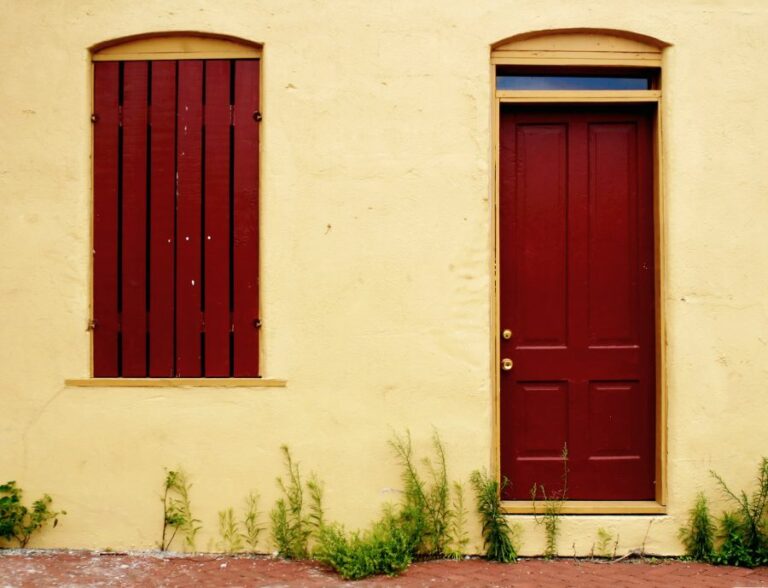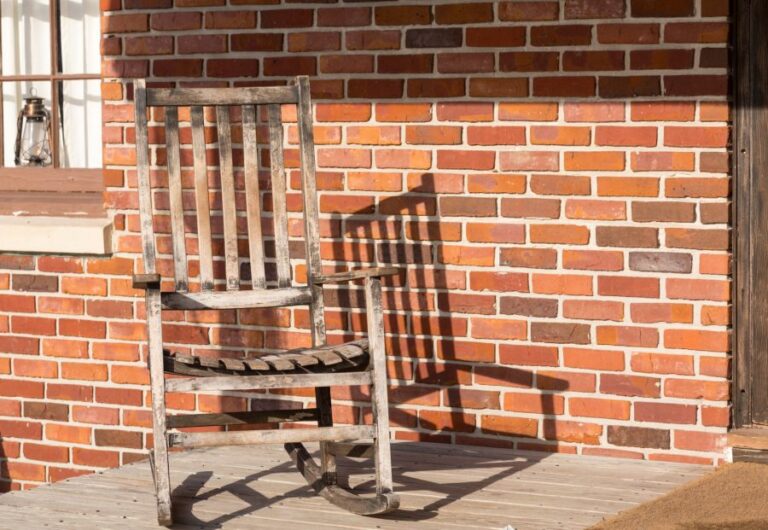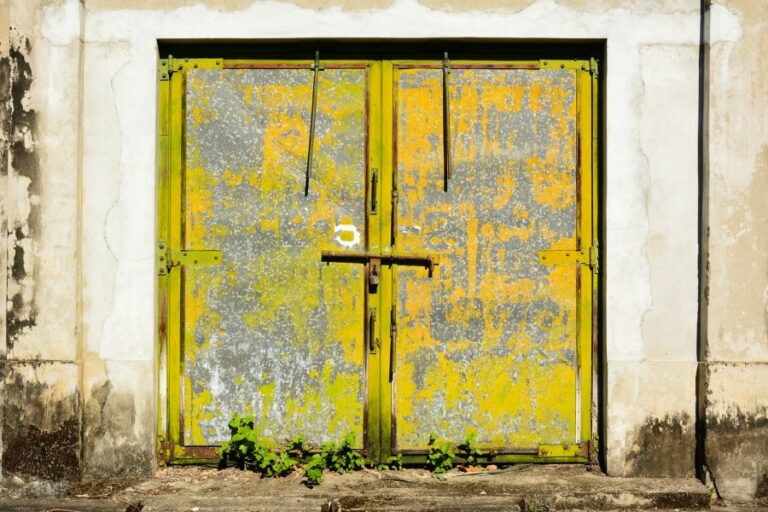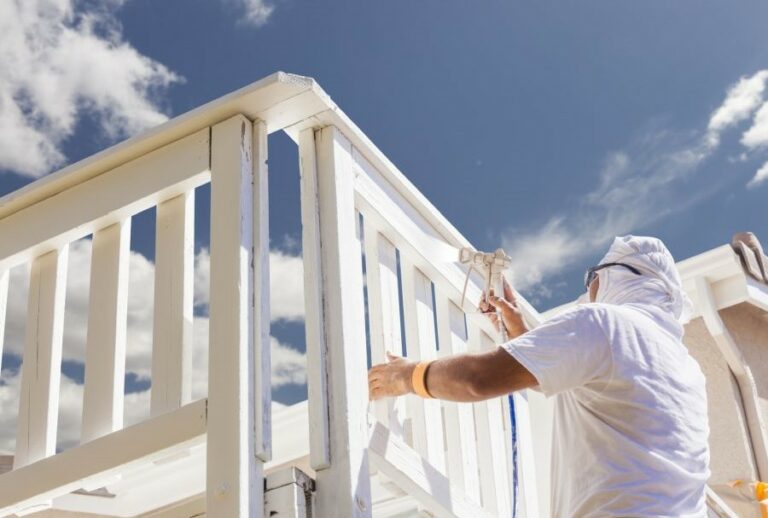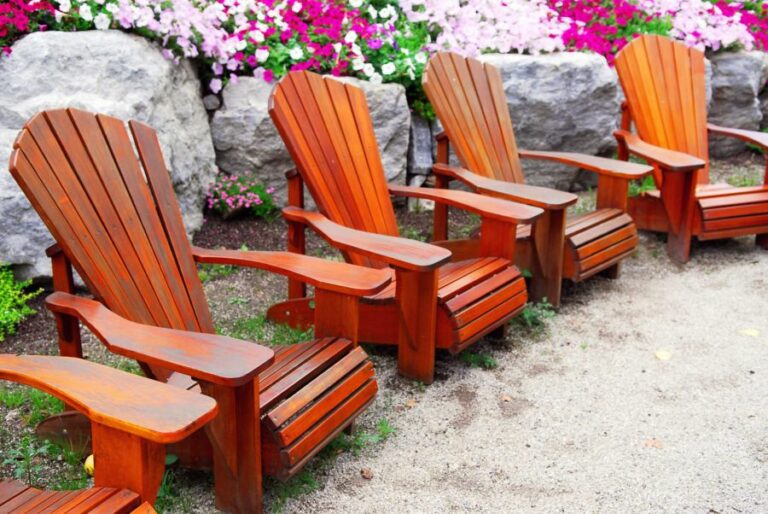Transform Your Outdoor Space with Concrete Patio Paint
Transform your dull and lifeless outdoor patio into a lively, welcoming space without breaking the bank! Find endless design possibilities with our comprehensive guide on outdoor patio concrete paint, which showcases the most affordable, durable, and stylish solutions for your home.
Outdoor patio concrete paint:
Outdoor patio concrete paint is essential to protect and beautify patios, making them more enjoyable and inviting. Various types of durable concrete paint, like acrylic latex, epoxy, and polyurethane, each with unique features and benefits. Proper surface preparation, including cleaning, repairing, etching, and neutralizing, is crucial for successful paint adhesion.
A step-by-step guide ensures smooth application and optimal results. Choosing the right paint, priming, mixing, and applying in thin, even coats, followed by adding additional coats and a sealer, helps achieve lasting professional results.

Discover the best concrete paint options for a beautiful, long-lasting patio surface. Enhance the beauty and functionality of your outdoor space with easy application tips, durability features, and trendy designs. Transform your patio into a stunning oasis today!
Contents
- 1 Exterior Patio Concrete Paint Solution
- 2 Which Kind of Paint is Most Suitable for Outdoor Concrete Surfaces?
- 2.1 • Understanding the Unique Challenges of Painting Outdoor Concrete
- 2.2 • Acrylic Latex Paint: A Versatile and Durable Option
- 2.3 • Epoxy Paint: A High-Performance Choice for Heavy-Duty Applications
- 2.4 • Concrete Stain: A Semi-Transparent Option for a Natural Look
- 2.5 • Final Thoughts: Choosing the Right Paint for Your Outdoor Concrete Project
- 3 Is it Possible to Apply Paint on an Outdoor Concrete Patio?
- 3.0.1 – Why Should You Paint Your Outdoor Concrete Patio?
- 3.0.2 – Necessary Materials and Tools
- 3.0.3 – Step 1: Inspect and Clean Your Concrete Patio
- 3.0.4 – Step 2: Repair Cracks and Damaged Area
- 3.0.5 – Step 3: Prime Your Concrete Patio
- 3.0.6 – Step 4: Choose the Right Paint for Your Patio
- 3.0.7 – Step 5: Apply the Paint to Your Concrete Patio
- 3.0.8 – Step 6: Allow Your Painted Patio to Dry
- 3.0.9 – Step 7: Enjoy Your Beautiful Concrete Patio
- 3.1 • Final Thoughts
- 4 Is Painting Outdoor Concrete a Long-Lasting Solution?
- 5 Is Outdoor Concrete Paint Effective?
- 6 Is it a Good Idea to Apply Paint on Concrete Surfaces?
- 7 Is it Suitable to Use Concrete Paint for Outdoor Applications?
Exterior Patio Concrete Paint Solution
• Why Concrete Paint is Essential for Your Patio
Your outdoor patio extends your living space, where you can enjoy sunny days and warm nights with family and friends. Over time, concrete patios can become unsightly due to weather elements, spills, and everyday wear and tear.
Outdoor patio concrete paint is the ideal solution to give your patio an instant facelift while protecting it from further damage.
• Types of Concrete Paint: Choose the Perfect Option
There are several outdoor patio concrete paint types, each with unique features and benefits. Let’s dive into the most common options:
– Acrylic Latex Paint
Acrylic latex paint is a popular choice for outdoor patios due to its durability and ease of application. It is water-based, non-toxic, and dries quickly, usually within a few hours.
Pros:
- Easy to apply and clean up
- Resistant to fading, cracking, and peeling
- Available in various colors and finishes
Cons:
- May require a primer on bare concrete
- Not as durable as epoxy or polyurethane paint
– Epoxy Paint
Epoxy paint offers extreme durability, making it an excellent option for high-traffic patios. This paint consists of a base and hardener, which must be combined before application.
Pros:
- Extremely durable and long-lasting
- Resistant to chemicals, abrasion, and stains
- Glossy finish adds a professional touch
Cons:
- Requires thorough surface preparation
- Longer drying and curing time
- May become slippery when wet
– Polyurethane Paint
Polyurethane paint is another durable option for patios, as it forms a protective barrier on the concrete surface. This paint is ideal for areas exposed to harsh weather conditions, such as sunlight, rain, and snow.
Pros:
- Highly resilient against weather elements
- Resistant to abrasion, chemicals, and stains
- Available in various colors and finishes
Cons:
- Requires precise surface preparation
- More challenging to apply than acrylic latex paint
- May require a primer on bare concrete
• Surface Preparation: The Key to a Flawless Result
Preparing the concrete surface ensures proper paint adhesion, avoiding bubbling and peeling. Follow these steps for optimal results:
- Clean the surface: Remove dirt, debris, and stains using a pressure washer or a stiff brush with mild detergent. Ensure the surface is spotless and free from oil, grease, or loose materials.
- Repair concrete: Fill any cracks or holes with concrete filler or patching compound, following the manufacturer’s instructions. Allow the repairs to cure before proceeding.
- Etch the surface: Etching the concrete with a solution of muriatic acid or a commercially available etching product will provide a better surface for paint adhesion. Be sure to follow all safety precautions and instructions provided by the manufacturer.
- Neutralize and rinse: After etching, neutralize the surface with baking soda and water, followed by a thorough rinse with clean water. Allow the concrete to dry completely before painting.
• How to Apply Outdoor Patio Concrete Paint
Once the surface is prepared, you can start the painting process. Here’s a step-by-step guide to help you achieve professional results:
- Choose the right paint: Select the appropriate type of paint based on your patio’s location, expected foot traffic, and desired finish.
- Prime the surface: If required by the paint you have chosen, apply a concrete primer with a roller or brush. Allow the primer to dry as per the manufacturer’s recommendations.
- Mix the paint: Follow the instructions to mix the components accurately for epoxy and polyurethane paints. Acrylic latex paint can be used straight from the can.
- Apply the paint: Using a roller or brush, apply the paint in thin, even coats. Work systematically, covering one section at a time. Allow each coat to dry based on the manufacturer’s recommendations before applying the next.
- Apply additional coats and sealer: Depending on the paint and desired results, you may need multiple coats. Consider applying a concrete sealer once the paint is fully cured for added durability and protection.
• Helpful Tips for a Successful Paint Job
- Work in ideal weather conditions, avoiding extreme heat, cold, or humidity.
- Use masking tape to protect any areas you do not want to paint.
- Regularly clean and maintain your painted patio to extend the paint’s lifespan.
In conclusion, outdoor patio concrete paint is an excellent solution to protect and beautify your patio, making it a more enjoyable and inviting space.
By understanding the different types of paint, carefully preparing the surface, and applying the paint correctly, you can achieve professional results that will stand the test of time.
Which Kind of Paint is Most Suitable for Outdoor Concrete Surfaces?
When painting outdoor concrete surfaces, choosing the right type of paint is crucial. Not all paints are suitable for outdoor conditions, even those that may not adhere well to concrete. We’ll explore the best paint types for outdoor concrete and some tips to help you achieve long-lasting results.
• Understanding the Unique Challenges of Painting Outdoor Concrete
Concrete is widely used for outdoor surfaces due to its durability and weather-resistant qualities. However, these very features also make it a challenging surface to paint. Here are some key factors to consider when choosing paint for outdoor concrete:
- Weather resistance: Outdoor concrete surfaces are exposed to the elements, so your paint must resist harsh sunlight and heavy rains.
- Adhesion: Concrete is porous, with tiny holes that trap air and moisture. This makes it difficult for paint to adhere properly, resulting in peeling, cracking, or bubbling over time.
- Durability: Foot traffic, heavy loads, and other causes of wear and tear can cause paint to wear off quickly, especially in high-traffic areas.
With these factors in mind, let’s explore the top paint choices for outdoor concrete surfaces.
• Acrylic Latex Paint: A Versatile and Durable Option
One of the most popular paint choices for outdoor concrete is acrylic latex paint. This type of paint offers several advantages:
- Water-based formula: Acrylic latex paints are water-based, making them easier to clean up and less environmentally harmful than oil-based paints.
- Wide range of colors and finishes: With a vast array of color options and various sheens, acrylic latex paint offers the versatility needed to achieve your desired look.
- Resistance to UV rays: Acrylic latex paints are formulated with UV-resistant additives that help protect the color from fading under sunlight.
- Expansion and contraction: Concrete surfaces can expand and contract with temperature fluctuations. Acrylic latex paint can flex with these changes, reducing the risk of cracking.
Apply two coats of acrylic latex paint using a roller, brush, or sprayer for the best results. Ensure sufficient drying time between coats, as the manufacturer recommends.
• Epoxy Paint: A High-Performance Choice for Heavy-Duty Applications
If your outdoor concrete surface is subjected to heavy foot traffic, vehicle traffic, or other high-wear conditions, epoxy paint may be your best choice. Epoxy paints offer several benefits:
- Exceptional durability: Epoxy paints form a hard, durable surface that can withstand abrasion, chemicals, and other harsh conditions.
- Excellent adhesion: Epoxies bond well to concrete surfaces, making them less likely to peel, bubble, or crack than other paint types.
- Waterproofing: Epoxy paints create a waterproof barrier that can help protect your concrete from moisture damage.
- Attractive finish: Epoxy paints often feature a glossy finish, enhancing the appearance of your concrete surface.
It’s important to note that applying epoxy paint to outdoor concrete can be more labor-intensive than other paint types. The surface must be thoroughly cleaned and prepared, sometimes requiring etching or acid washing to ensure proper adhesion.
Additionally, epoxy paints typically consist of a two-part system (a resin and a hardener) that must be mixed before application.
• Concrete Stain: A Semi-Transparent Option for a Natural Look
Consider using a concrete stain if you want a more natural appearance for your outdoor concrete. These water-based stains penetrate the concrete surface, creating a semi-transparent finish that enhances the material’s natural texture. Key benefits of concrete stains include:
- UV resistance: Most concrete stains are formulated to resist fading from sunlight, ensuring a lasting color.
- Breathability: Concrete stains allow moisture to escape from the surface, preventing peeling or blistering.
- Ease of application: Unlike epoxy paints, concrete stains can be applied using a pump sprayer, roller, or brush without mixing components.
While concrete stains are ideal for achieving a natural look, they may not provide the same level of durability as acrylic latex or epoxy paints.
• Final Thoughts: Choosing the Right Paint for Your Outdoor Concrete Project
Ultimately, the best paint for your outdoor concrete project will depend on your needs, budget, and desired appearance. Acrylic latex paint is a versatile and user-friendly option for many applications, while epoxy paint offers high-performance durability for heavy-duty conditions. A concrete stain might be your best choice if you’re after a more natural look.
Proper surface preparation and application are crucial to achieving a long-lasting finish regardless of which type of paint you choose. Always follow the manufacturer’s recommendations for cleaning, priming, and applying the paint to ensure optimal results.
By considering the unique challenges of painting outdoor concrete and selecting the appropriate paint type, you can achieve a beautiful, durable finish that will enhance and protect your outdoor space for years.
Name of Paint | Type | Pros | Cons |
|---|---|---|---|
Concrete Stain | Water-Based / Acid-Based | Durable, UV-resistant, natural appearance | Less durable, solvent-based dyes have a strong odor and may require reapplication |
Acrylic Latex Paint | Water-Based | UV-resistant, weather-resistant, wide color options | Less durable than other types, may require reapplication |
Epoxy Paint | Two-Part System | Extremely durable, chemical-resistant, customizable appearance | Difficult to apply, longer drying time, requires surface preparation |
Concrete Dye | Water-Based / Solvent-Based | Easily penetrates concrete, UV-resistant, wide color options | Less durable, solvent-based dyes have a strong odor, and may require reapplication |
Is it Possible to Apply Paint on an Outdoor Concrete Patio?
Unlock the full potential of your outdoor space by giving your concrete patio a new, refreshing look through the simple task of painting. Yes, you can paint your outdoor concrete patio, but it is crucial to prepare and select the appropriate materials correctly.
I will cover the step-by-step process of painting an outdoor concrete patio and give helpful tips. Let’s dive in!
– Why Should You Paint Your Outdoor Concrete Patio?
Before we delve into the how-to’s, it’s essential to understand the reasons for painting your outdoor concrete patio:
- Enhance the aesthetics of your outdoor space
- Protect against weather damage and fading
- Improve skid resistance to minimize accidents
- Maintain a clean and even appearance by concealing cracks and stains
- Increase the overall value of your property
Now that the benefits are clear let’s move on to the step-by-step process.
– Necessary Materials and Tools
To ensure a smooth painting process, gather the following materials and tools before beginning:
- Outdoor concrete paint or stain (preferably water-based)
- Concrete primer or sealer
- Concrete cleaner or mild detergent
- Paintbrushes and rollers
- Paint tray
- Bucket and water
- Broom or leaf blower
- Pressure washer (optional)
- Wire brush
- Painter’s tape
- Safety gear (gloves, goggles, and mask)
With these tools, you’re all set for a successful patio makeover.
– Step 1: Inspect and Clean Your Concrete Patio
A thorough inspection and cleaning of your outdoor concrete patio are necessary before applying any paint. This ensures that the paint adheres to the surface properly and lasts longer. Start by examining the surface for any existing paint, cracks, or stains. The concrete may require minor repairs or patching.
Proceed by sweeping off debris, leaves, or dust using a broom or leaf blower. Clean the entire surface using a concrete cleaner or mild detergent, paying close attention to stains, mold, or mildew. For extensive cleaning, consider using a pressure washer to remove deep-seated dirt.
Allow the patio to dry completely before moving on to the next step.
– Step 2: Repair Cracks and Damaged Area
After a thorough inspection, repair any cracks, chips, or damaged areas with a concrete patching compound. Follow the manufacturer’s instructions to achieve the best results. Allow the patched area to dry and cure for the recommended time.
– Step 3: Prime Your Concrete Patio
Primers serve as a foundation for the paint, ensuring proper adhesion and preventing peeling or flaking. Apply a concrete primer or sealer using a paintbrush, roller, or sprayer.
Allow the primer to dry as specified in the manufacturer’s instructions. In most cases, drying time ranges from a few hours to a full day.
– Step 4: Choose the Right Paint for Your Patio
Choosing the right paint for your outdoor concrete patio is crucial. Select a paint specifically designed for outdoor concrete surfaces. Water-based paints are highly recommended as they are less toxic, easy to clean, and dry quickly.
The paint should also have properties that resist fading, weather damage, and skid. Moreover, consider the patio’s exposure to sunlight and moisture, as these factors will affect the paint’s durability.
– Step 5: Apply the Paint to Your Concrete Patio
With your patio primed and paint selected, it’s time to apply the paint. Use a paintbrush for tight areas and corners, while a roller or sprayer suits larger surfaces. Apply thin, even layers of paint to avoid drips or an uneven finish. Allow the paint to dry according to the manufacturer’s instructions, typically between two to six hours.
Applying at least two coats of paint is usually recommended to achieve a uniform and durable finish. Allow the first coat to dry completely before applying a second coat, ensuring enough time has passed as specified in the manufacturer’s instructions.
– Step 6: Allow Your Painted Patio to Dry
Allow adequate drying time for the paint to adhere properly to the concrete surface. Most manufacturers suggest waiting at least 24 hours before placing furniture or walking on the painted surface. Sometimes, the paint may take up to 72 hours to cure completely.
– Step 7: Enjoy Your Beautiful Concrete Patio
Finally, it’s time to enjoy your refreshed and revitalized outdoor space! Place your furniture, plants, and accessories back onto your patio and relish your painted concrete surface’s new, appealing look.
• Final Thoughts
As demonstrated, painting your outdoor concrete patio is an achievable project to greatly enhance your outdoor space. Following the steps and tips in this guide will ensure a successful result with long-lasting appeal. Go ahead and give your patio the makeover it deserves!
| Can you paint an outdoor concrete patio? |
|---|
| Yes, you can paint an outdoor concrete patio. Choose an appropriate paint, clean and prepare the surface, and follow the paint manufacturer’s instructions for the best results. |
Is Painting Outdoor Concrete a Long-Lasting Solution?
• Importance of Painting Outdoor Concrete
Outdoor concrete surfaces are exposed to various environmental factors such as sunlight, rain, and temperature fluctuations. These factors can cause wear and tear on the concrete, leading to cracks, fading, and chipping.
Painting outdoor concrete is a popular choice for homeowners and property managers because it provides a protective layer while enhancing the visual appeal of the concrete surfaces. However, the common question is, does painting outdoor concrete last?
I will discuss the longevity and durability of painted outdoor concrete, factors influencing the paint’s lifespan, and the best practices for maintaining and maximizing the paint job’s longevity.
• Longevity of Painted Outdoor Concrete
The lifespan of painted outdoor concrete depends on several factors, such as the paint quality, surface preparation, application technique, and environmental conditions.
Properly painted outdoor concrete, using high-quality paint and following best practices, can last anywhere from 3 to 10 years or even longer, depending on these factors.
– Paint Quality
The first factor influencing the longevity of painted outdoor concrete is the quality of the paint itself. High-quality concrete paint, specifically designed for outdoor use, contains ingredients that help the paint withstand harsh weather conditions such as sunlight, rain, and temperature fluctuations.
Investing in paint specifically formulated for outdoor concrete surfaces, such as acrylic or epoxy-based paints, is essential. These paints are designed to be more durable and resistant to weathering.
– Surface Preparation
Proper surface preparation is crucial for a long-lasting paint job. Thoroughly cleaning and repairing any damaged areas of the concrete surface before painting will ensure better adhesion of the paint and will prevent premature paint failure.
Pressure-washing the surface, removing any loose or flaking paint, and filling in cracks with a concrete filler are necessary to prepare the surface for painting.
– Application Technique
The application technique plays a vital role in the longevity of a painted outdoor concrete surface. Applying multiple thin coats of paint ensures better adhesion, even coverage, and long-lasting results.
Using a primer before applying the paint is also advisable, as it helps create a strong bond between the paint and the concrete surface.
– Environmental Conditions
The lifespan of painted outdoor concrete is also influenced by the environmental conditions it is exposed to. Harsh weather conditions, such as extreme temperatures, heavy rainfall, or extended periods of direct sunlight, can affect the integrity and durability of the paint job.
Proper drainage and minimizing water pooling on the concrete surface can help prevent premature paint failure due to the weather.
• Best Practices for Maintaining Painted Outdoor Concrete
To maximize the longevity of your painted outdoor concrete, follow these maintenance tips:
– Regular Cleaning
Keep the painted surface clean by periodically sweeping or pressure-washing it. This helps remove dirt, debris, and other contaminants that can cause the paint to deteriorate over time. Avoid harsh chemicals or abrasive cleaning tools, as these can damage the paint.
– Prompt Repair
In case of any damage, such as chips, cracks, or flaking paint, address the issue promptly. Clean and repair the damaged areas, and apply a fresh coat of paint as necessary to maintain the integrity and appearance of the painted surface.
– Apply Protective Sealant
Applying a protective sealant on top of the paint can enhance the durability and longevity of the paint job. Sealants create a barrier against environmental factors and can extend the paint’s lifespan by several years. Choose a sealant compatible with the paint used on your concrete surfaces.
– Rotate Furniture and Decor
Consider rotating or rearranging the items periodically if your painted outdoor concrete is in an area with furniture or decor. This helps prevent uneven wear and tear, prolonging the paint’s lifespan.
• In Conclusion
In summary, the longevity of painted outdoor concrete depends on various factors, including paint quality, surface preparation, application technique, and environmental conditions. Following best practices and maintenance tips ensures long-lasting and visually appealing outdoor concrete surfaces.
Whether a homeowner or a property manager, investing in high-quality paint and proper preparation is essential to ensure your painted outdoor concrete lasts for years. With the right care and maintenance, you can enjoy beautiful, durable outdoor concrete surfaces that stand the test of time.
Is Outdoor Concrete Paint Effective?
Outdoor concrete paint is a popular option for home and business owners looking to improve the appearance and durability of their concrete surfaces. But does it work? I will discuss the effectiveness of outdoor concrete paint, application tips, and the types of paint suitable for various surfaces.
• Understanding the Role of Outdoor Concrete Paint
Outdoor concrete paint serves several purposes, including:
- Aesthetic improvement: Fresh paint colors can significantly enhance the appearance of a concrete surface, making it look more attractive and cohesive with the surrounding environment.
- Weather resistance: Concrete paint provides a protective layer that guards against elements such as rain, wind, and sun exposure, reducing wear and tear on the surface.
- Surface durability: Painted concrete is generally more resistant to staining, chemicals, and abrasion than untreated surfaces.
• Evaluating the Effectiveness of Outdoor Concrete Paint
To determine whether outdoor concrete paint works, it is essential to understand the factors that influence its performance. This includes surface preparation, paint type, and application method.
– Surface Preparation
Proper surface preparation is crucial for ensuring the effectiveness and longevity of the paint. The concrete should be clean, dry, and free of loose or peeling paint, dirt, and debris. This will allow the paint to adhere properly to the surface, ensuring a durable finish.
Here are some tips for preparing your concrete surface:
- Clean the surface with a pressure washer or a garden hose with a high-pressure attachment to remove dirt and debris.
- Remove loose or peeling paint using a scraper, wire brush, or power sander.
- Repair any cracks or holes with a concrete patching compound.
- Allow the surface to dry for at least 24 hours before painting.
I recommend following these steps to ensure proper adhesion and a long-lasting result.
– Types of Outdoor Concrete Paint
Several types of outdoor concrete paint are available on the market, each with unique properties and benefits.
- Latex-based paint: Also known as water-based paint, latex paint is easy to apply, dries quickly, and offers good adhesion to concrete surfaces. It is also resistant to yellowing and fading, making it suitable for outdoor use.
- Acrylic paint: This type is designed for outdoor concrete surfaces, offering excellent durability, UV resistance, and water repellency. Acrylic paints are known for their ability to expand and contract with temperature fluctuations, reducing the risk of peeling or cracking.
- Epoxy paint: Offering exceptional durability and chemical resistance, epoxy paint is suitable for heavy-duty applications, such as garage floors and industrial settings. However, it has a more complex application process and may not be the best choice for DIY projects.
When selecting a paint for your outdoor concrete surface, consider factors such as durability, UV resistance, and cost to determine the best product for your specific needs.
– Application Tips for Outdoor Concrete Paint
To ensure the effectiveness of your outdoor concrete paint, follow these application tips:
- Thin coats: Applying thin, even coats of paint is more effective than a single thick coat. This allows the paint to dry properly and promotes better adhesion to the surface.
- Proper drying time: Allow each coat of paint to dry for the recommended time before applying additional coats. This is typically at least 4 hours for latex and acrylic paints and up to 24 hours for epoxy paint.
- Surface temperature: Avoid painting on hot days or in direct sunlight, as this can cause the paint to dry too quickly, resulting in poor adhesion and a less durable finish. Aim to apply the paint when the surface temperature is between 50 and 90 degrees Fahrenheit.
- Weather conditions: Do not apply outdoor concrete paint during rainy or windy conditions, as this can interfere with the drying process and compromise the paint’s effectiveness. Instead, wait for dry and calm weather.
By following these recommendations, you can maximize the effectiveness and longevity of your outdoor concrete paint.
• Conclusion: Does Outdoor Concrete Paint Work?
In summary, outdoor concrete paint can be effective when applied correctly to a properly prepared surface with the appropriate type of paint. By preparing the surface, choosing the right paint, and applying it correctly, you can achieve a durable and attractive finish for your outdoor concrete surfaces.
However, it is essential to recognize that paint is not a permanent solution, and even the best outdoor concrete paint will require maintenance and eventual repainting. Regularly inspecting and maintaining your painted surfaces will help ensure the paint’s effectiveness and preserve your investment in outdoor concrete projects.
Is it a Good Idea to Apply Paint on Concrete Surfaces?
Painting concrete surfaces can be tempting for several reasons, whether improving the appearance, increasing durability, or protecting against harmful elements.
However, before reaching for the paintbrush, it is essential to examine the pros and cons of this action, along with some crucial factors such as surface preparation and proper maintenance.
• Advantages of Painting Concrete
– Aesthetic Appeal
A fresh coat of paint can instantly transform and enhance the visual appeal of a drab and monotone concrete surface.
Paint is available in various colors and textures, making it suitable for blending into the existing environment, adding a pop of color, or mimicking the look of expensive natural materials such as stone or wood.
– Protection against Elements
Concrete, although durable, is prone to wear and tear from weather exposure, moisture, and chemicals. Applying a coat of high-quality paint can protect the concrete from these elements, prolonging its life and minimizing the chances of deterioration, staining, and damage.
– Easy Maintenance and Cleaning
Painted concrete surfaces are easier to clean than bare concrete, as the paint is a barrier against dirt, mold, and mildew. A simple blend of soap and water is usually sufficient to wash away any dirt buildup, ensuring that the surface remains in good condition for an extended period.
• Disadvantages of Painting Concrete
– Peeling and Flaking
One of the primary issues with painting concrete is the potential for the paint to peel or flake off. This occurs mainly due to inadequate surface preparation or incorrect paint, resulting in poor adhesion to the concrete.
Moreover, the paint might not effectively penetrate the concrete’s porous nature, leading to eventual paint failure.
– Reduced Breathability
A significant characteristic of concrete is its breathability, which allows moisture to escape through its surface. Painting a concrete surface with dense, non-breathable paint can trap moisture, potentially resulting in dampness, mold, and the eventual breakdown of the concrete.
– Frequent Repainting
Certain concrete surfaces, such as heavily used walkways or driveways, might require frequent repainting due to the high level of wear and tear. This can lead to increased maintenance costs over time.
• Surface Preparation for Painting Concrete
The success of painting concrete largely depends on proper surface preparation. Properly preparing the surface ensures that the paint adheres well and lasts long.
– Cleaning the Surface
Begin by thoroughly cleaning the concrete surface to remove dirt, debris, or stains. Use a pressure washer or a mixture of soap and water, scrubbing with a stiff-bristled brush to eliminate stubborn dirt.
Ensure the area is clean and free from oil, grease, or mold, as these contaminants can significantly hinder paint adhesion.
– Repairing Cracks and Damage
Inspect the concrete surface for any visible cracks, chips, or damage that must be repaired. Use a concrete repair compound to fill gaps or cracks, ensuring the surface is smooth and even before painting.
– Testing for Moisture
Before painting, confirming that the concrete surface is entirely dry and moisture-free is essential. Perform a simple moisture test by taping a small piece of plastic sheeting to the surface and leaving it for at least 24 hours.
If any condensation or dampness is present on the plastic or the concrete, it is vital to identify and address the moisture source before painting.
– Etching the Surface
Concrete surfaces with a smooth, dense texture may require etching to promote adequate paint adhesion. Etching involves applying a concrete etchant or muriatic acid to the surface, which reacts with the concrete, roughens its texture, and opens up the pores to ensure better paint penetration.
• Choosing the Right Paint and Applying It Correctly
After preparing the surface, selecting the appropriate paint is vital for achieving a long-lasting, attractive finish.
– Opt for Concrete-Specific Paint
Ensure that the paint chosen is specifically formulated for concrete surfaces. These paints contain binders and additives that promote better adhesion and durability and resist peeling, flaking, or fading.
– Apply a Concrete Primer
A high-quality concrete primer before painting can significantly enhance paint adhesion and durability. Primers also help mask surface inconsistencies and create an even base for the paint.
– Use Best Painting Practices
When painting the concrete surface, use a paint roller or brush, applying the paint in thin, even coats. Two to three coats of paint are recommended for sufficient coverage and optimum results. Follow the manufacturer’s instructions regarding drying times between coats and any additional recommendations.
• Maintaining Painted Concrete Surfaces
To ensure the longevity of the painted concrete surface, properly maintaining it is necessary. Clean the surface regularly and check for signs of wear, damage, or peeling paint. If any issues arise, promptly address them to minimize long-term damage and to keep the surface looking great.
• Conclusion
Considering the many benefits and potential drawbacks, painting concrete correctly can be a good idea. Proper surface preparation and choosing the right paint are essential for successful concrete painting projects.
Whether to paint a concrete surface depends on the area’s specific requirements and desired outcomes.
Is it Suitable to Use Concrete Paint for Outdoor Applications?
Concrete paint can be a fantastic way to transform the appearance of various surfaces outdoors. With its durability and versatility, there is no doubt that concrete paint can be an excellent choice for exterior applications.
This guide aims to answer the question, “Can concrete paint be used outside?” It will also provide helpful tips on choosing the right type of paint, preparing the surface, applying the paint, and maintaining your freshly painted surfaces.
• Types of Concrete Paint Suitable for Outdoor Use
Not all concrete paints are suitable for outdoor use. Choosing a paint explicitly designed for exterior surfaces to withstand weather conditions and resist fading, peeling, and cracking is essential. There are several types of concrete paint available in the market that are well-suited for outdoor projects:
– Epoxy Paint
Epoxy paint is a two-component paint that consists of resin and a hardener. It is highly durable and resistant to chemicals, stains, and abrasion. Epoxy paint creates a strong bond with the concrete surface, making it ideal for high-traffic areas like driveways, walkways, and patios.
– Acrylic Paint
Acrylic paint is a water-based paint made from acrylic resins. It is UV resistant, maintaining its color and appearance even when exposed to direct sunlight. Acrylic paint is also breathable, which prevents moisture from getting trapped beneath the paint film.
This feature helps prevent issues like mold, mildew, and peeling. Acrylic paint can be used on various surfaces, including concrete, stucco, and masonry.
– Elastomeric Paint
Elastomeric paint is a high-build, flexible coating that can bridge small cracks and gaps on concrete surfaces. It has exceptional waterproofing properties, making it an excellent choice for outdoor concrete surfaces exposed to moisture.
Additionally, elastomeric paint can expand and contract with temperature changes, making it less prone to cracking and peeling.
• Surface Preparation for Outdoor Concrete Painting
Properly preparing the surface is crucial for successful outdoor concrete painting. This helps to ensure long-lasting results and prevents common paint problems, such as peeling, flaking, and blistering. Below are some essential steps to follow before applying paint:
– Clean the Surface
Remove dirt, grease, oil, and other contaminants from the surface using a pressure washer, degreaser, or other appropriate cleaning solutions. Ensure that the surface is completely dry before proceeding to the next step.
– Repair Damaged Areas
Inspect the surface for any cracks, holes, or other damage that might need repairing. Use a suitable patching compound or filler to fix damaged areas, and allow the repairs to cure according to the manufacturer’s instructions.
– Apply a Concrete Primer
Using a concrete primer can improve the adhesion of the paint and increase its overall durability. Follow the manufacturer’s instructions for the appropriate primer application, and allow it to dry completely before applying the paint.
• Outdoor Concrete Painting Techniques
When painting outdoor concrete surfaces, the right technique is essential to achieve a professional finish. Here are some essential tips for applying paint:
– Choose the Right Tools
Use a high-quality roller with a medium to long nap for smooth surfaces. A brush or sprayer may be more effective for rough or textured surfaces.
– Apply Thin, Even Coats
Applying thin, even coats of paint will result in a smooth, consistent finish. Avoid excessive paint, which may lead to uneven coverage and peeling paint.
– Allow Sufficient Drying Time
Allow the paint to dry according to the manufacturer’s instructions between coats. Drying times can vary depending on factors like humidity and temperature, so it is crucial to be patient and ensure that the paint is fully cured before applying additional coats or using the surface.
• Maintenance Tips for Painted Outdoor Concrete Surfaces
Proper maintenance is crucial to extending the life of your painted outdoor concrete surfaces. Here are some helpful tips to keep your surfaces looking great:
– Regular Cleaning
Keep the surface clean by regularly sweeping or washing away dirt, debris, or stains. Avoid using harsh chemicals, as they can damage the paint film.
– Reapply Paint as Needed
Over time, painted surfaces may show signs of wear or fading. Reapply paint as needed to keep the surface looking fresh and well-maintained.
– Protect the Surface
Place protective coverings or mats under furniture or other objects that may scratch or damage the painted surface.
In conclusion, concrete paint can indeed be used outside and is an excellent way to enhance and protect your outdoor surfaces.
By choosing the right type of paint, properly preparing the surface, applying the paint using the appropriate techniques, and maintaining the painted surfaces, you can achieve long-lasting, attractive results that add value and appeal to your property.

